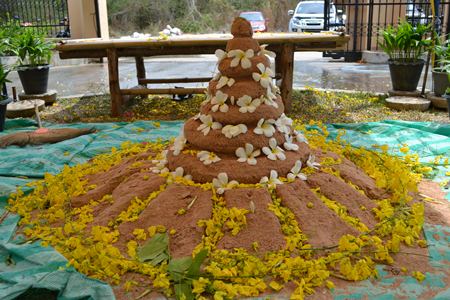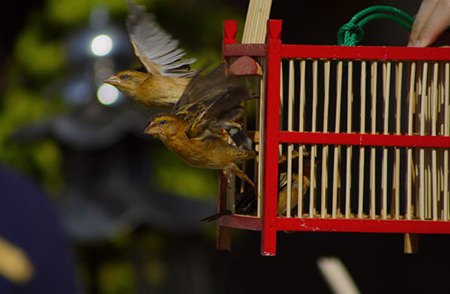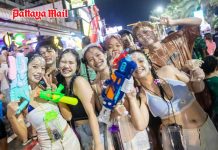Celebrated since ancient times, Songkran long has represented compassion, love, bonds towards families, communities, society and religion. But, in today’s world, it has also gained importance as a free-wheeling holiday dominated by water play and drinking.
Water is the symbol representing a solution to the summer heat and the end of a Thai lunar year known as “troot.” As the sun moves from Pieces to Aires, the calendar marks a fresh start, or “Songkran.”
The gentle sprinkling of water on the hands or shoulder in years past was an appeal for blessings from a father, mother, and maternal or paternal grandparents. Respects were paid to ancestors by making merit, building unity within community by dedicating merits to the sand pagoda, and preservation of religion.
 Ancient folklore tells that after their visits, citizens would leave temples with sand pebbles stuck on their feet. Therefore, people would bring sand into temples or even build sand pagodas during the evening.
Ancient folklore tells that after their visits, citizens would leave temples with sand pebbles stuck on their feet. Therefore, people would bring sand into temples or even build sand pagodas during the evening.
Times have changed, people have moved to cities and considered Songkran as the occasion to return home, causing paralyzing traffic during days before Songkran, the first day of Songkran and the final day of the festival. In addition, Songkran is an event that promotes tourism by Thais and foreigners. Currently, Songkran has been developed and modified in such a way that it is known as the water festival, where water is just a symbol of playing.
The Thai calendar declares the official Songkran holiday as April 13-15. Nevertheless, the official dates are made after calculations of the principles of the lunar calendar.
Since ancient days, the first day of Songkran is the day when the sun moves to Aires, also called as “Maha Songkran Day.” The second day is called “Wan Nao” and the final day “Chula Sakarat.” Hence, Songkran festival this year falls between April 13 and 17.
Activities on Maha Songkran Day consist of people waking up early to prepare food placed into beautiful china, laid out on trays to present as alms and as lunch for local monks. People would dress nicely and cover themselves appropriately for visiting the village temple.
Ancient folklore tells that after their visits, citizens would leave temples with sand pebbles stuck on their feet. Therefore, people would bring sand into temples or even build sand pagodas during the evening. Monks would usually throw the sand back into rivers, as there is no particular use of sand.
Releasing fish into the wild is another activity performed meticulously by all those who visit the temple with the belief that merit should be made and releasing fish brings much merit. Giving a new life to an animal that has been captured is considered as monumental merit.
Water pouring on statues of Lord Buddha with flowers, candles for worshipping and spraying Thai perfumed water without alcohol is a perfunctory action that pays respect to Lord Buddha on New Year’s.
Water is also poured on monks, but usually it’s the abbot who would spray water. After spraying water on disciples, the abbot would don new robes that disciples have presented before the he preaches dharma and give New Year’s blessings to worshippers.
The water pouring ceremony extends to citizens, who would pour water on the hands of revered adults or seniors, to ask for blessings.





